Statorade

Statorade is a line of low viscosity magnetically suspended motor cooling fluid that was jointly developed by Grin Tech, a pioneer in ebike R&D, and Ferrotec, the inventor and undisputed leader of Ferrofluid science since the 1960’s.
How it Works
The idea behind Statorade is brilliant and simple. A direct drive hub motor generates heat internally at the stator, but this heat has no easy path to escape since it is surrounded by trapped air. It is possible to cool the motor with vent holes and active airflow from outside, but this exposes the motor to the elements. Alternately, filling the motor with oil will cool the stator windings quite well, but with significant increase in motor resistance from fluid drag and an enormous sealing challenge to keep the oil from leaking
With Statorade, only a tiny amount of fluid is needed to achieve the same effect. Nanomagnetic particles suspended in a low-viscosity oil concentrate this liquid in the magnetic air gap of the motor. That is exactly where it needs to be to transfer heat through fluid convection between the motor stator to the motor shell, where the heat can then be easily shed to the environment via passing airflow.
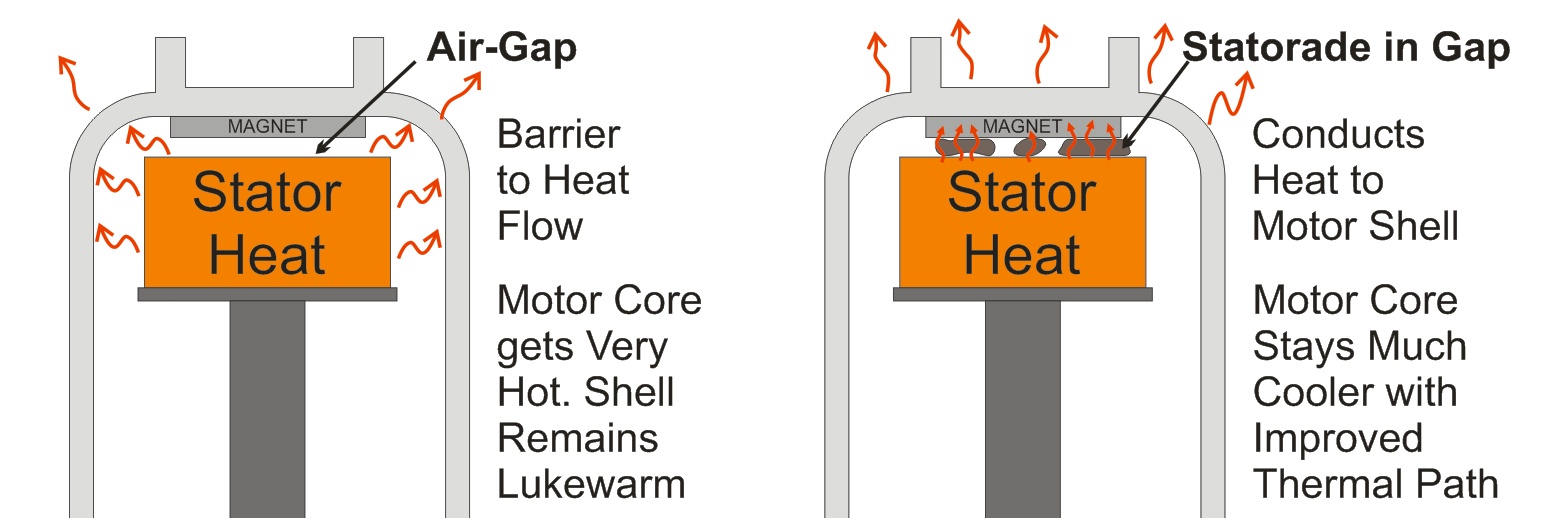
The magnets on the rotor trap the fluid in the gap so that it can’t splash around and leak out through the ball bearings or cable wiring as happens with normal attempts at oil cooling. And it turns out that only a tiny amount of Statorade fluid is needed to achieve heat transfer, resulting in negligible effect on the rolling drag of the motor.
How Well Does It Work?
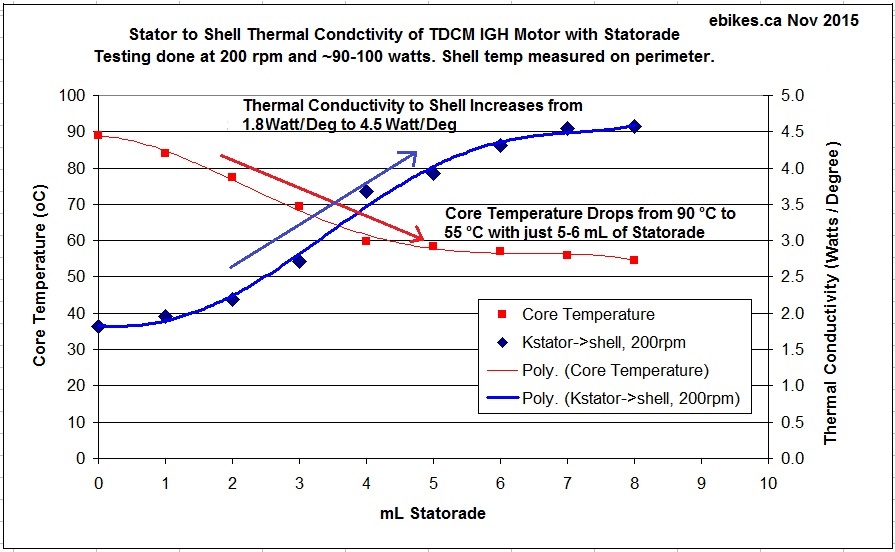
The short answer is very well, on average roughly doubling the thermal conductivity from the copper windings to the outside environment. That is similar to the cooling performance improvement achieved by drilling very large vent holes on both side cover plates, but without any of the exposure consequences. At low speed Statorade does a slightly better job, while at high speeds the active air flow has an edge.
In the graph on the left, you can see the effects of adding Statorade to the TDCM 5 Speed IGH hub motor in 1mL increments. By the time we get to 6mL of Statorade added to the motor, the thermal conductivity from the copper to the motor shell has increased from 1.8 to 4.3 Watts/Deg, and the steady state motor core temperature has reduced from nearly 90 °C to less than 60 °C.
What does this mean in practice? Well, if you can double the amount of heat that a motor can dissipate, it means (due to the I2R relationship) you can run it at roughly 40% higher sustained torque and power without overheating. 40%! In practice, what this means is that bike rides that used to push your hub motor to 100+°C will now only result in ~70°C temperatures. And when the motor does get hot from a short intense power burst, then it be that much faster at cooling down and being ready for the next thrust of high power.
Of course, with a given motor controller and battery setup the motor isn’t going to feel any different once you add Statorade, off the line torque and everything will be exactly the same. It’s only when you are monitoring the motor temperatures that you truly see and appreciate the effect, and can expand your usage window accordingly.
We’ve created a very powerful ebike simulation tool that takes all of the firsthand data from our wind tunnel experiments and modeled a full hub motor and ebike environment around it. You can then directly compare any given trip simulation for a motor with and without Statorade addition and see for yourself how the core temperatures are reduced.
How Much to Use?

One of the most fascinating aspects of Statorade is just how little is required to achieve these thermal benefits. With conventional oil cooling of a hub motor people would typically add several hundred mL of ATF oil or similar in order to get good thermal linkage which results in measurable extra drag from fluid friction. With Statorade, we start to see measurable improvements in heat dissipation with just 2-3 mL, and on most hub motors the full effect is reached with somewhere between 5-8 mL at modest RPMs, and 8-12mL for fast RPMs. If more Statorade is added beyond this, then there is almost no change in the heat flow but you will start getting increasing viscous fluid drag. In the graph below, you can see the effects of adding Statorade 1mL at a time on a large 40mm wide MXUS direct drive hub motor.
If you aren't sure of the ideal fill amount for your hub, then we recommend measuring the no-load current draw of your motor at full throttle, then adding the Statorade in small increments at a time until you start to see a measurable increase in the unloaded current. This is the point where additional Statorade will mostly increase your rolling drag without adding much thermal benefit.
Hubsinks
While Statorade does an excellent job of forming a thermal bridge between the motor core and the spinning shell, it doesn't do anything to assist moving heat from the shell itself to ambient air. In general the passing airflow from riding the bike will do a very good job of this. But for maximum cooling effect the addition of fins to the motor shell will provide further improvement, increasing the total heat flow by 15-20% over just Statorade alone. Matt from Strike3productions has created an innovative Hubsink product that is designed exactly for this purpose. The segmented fins can be inserted between the spokes of a laced wheel and bolt together, providing a finned surface to facilitate heat shedding from the motor shell.
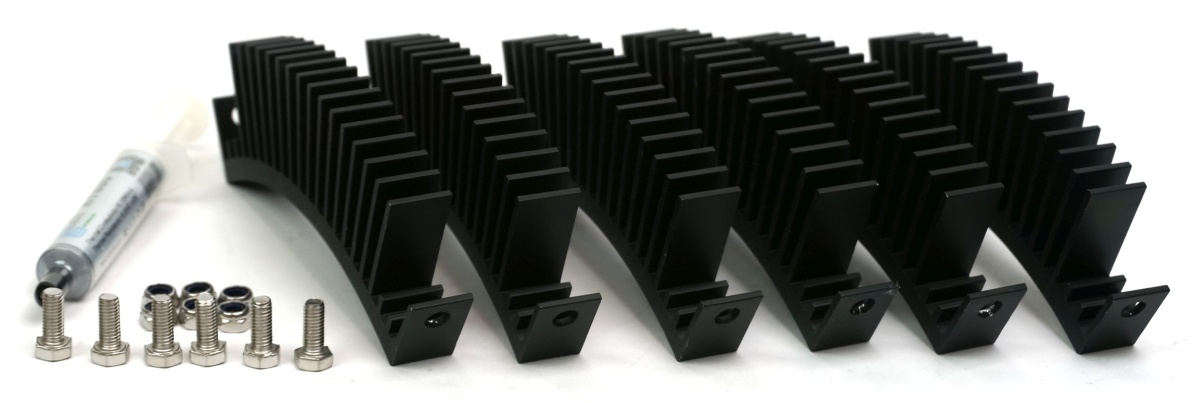

The graphs below do a great job of showing just how Hubsinks work based on our testing of a Cromotor. On the left you see the core to shell conduction. The addition of 12mL Statorade to the core causes a huge increase in core to shell heat transfer, while hubsinks on top of this don't do anything. In the middle graph we are looking at the heat conductivity from the motor shell to ambient air. The addition of Statorade has virtually no effect, while the Hubsinks result in a 50-60% improvement over the natural conduction of a bare motor shell. Finally in the third graph we see the total effects on the net heat flow out of the motor, with 12mL Statorade improving things by ~80% and Hubsinks putting another 20% improvement over this.

Test Results
We've characterized the effects of Statorade for improved motor cooling in over a dozen different hub motor lines, from tiny skateboard motors, to small Brompton kit motors like the SAW20, to very large hub monstrosities like the Cromotor. Many of those test graphs are shown below. We also did a detailed study of the improvements that could be expected from Statorade use in the BionX motor series.
This was an application of strong interest to us since the improved motor cooling would also help with controller performance, as the motor controller is built inside these hubs. The paper also demonstrates how to use our simulator tools to model the expected real-world improvements in motor torque, power, and hill climbing speed when the hub is in thermal rollback.
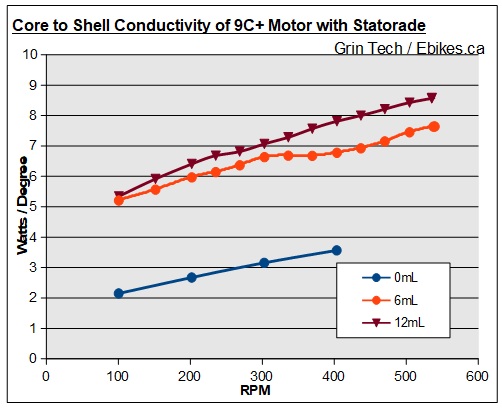
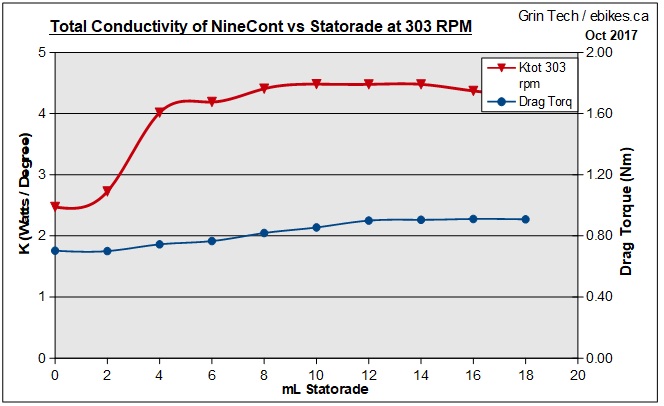
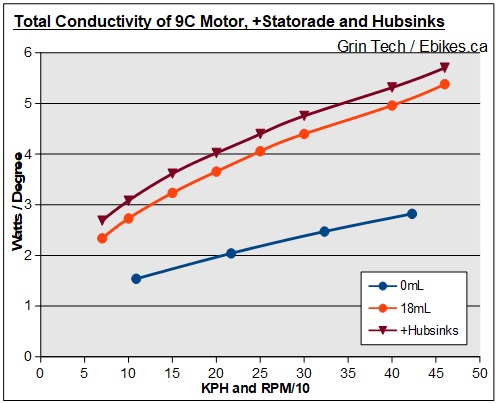
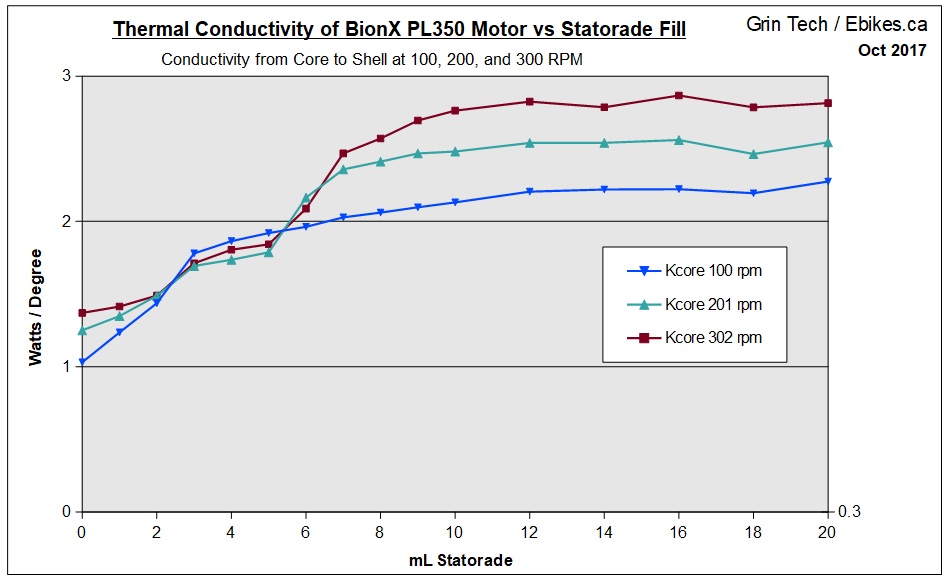
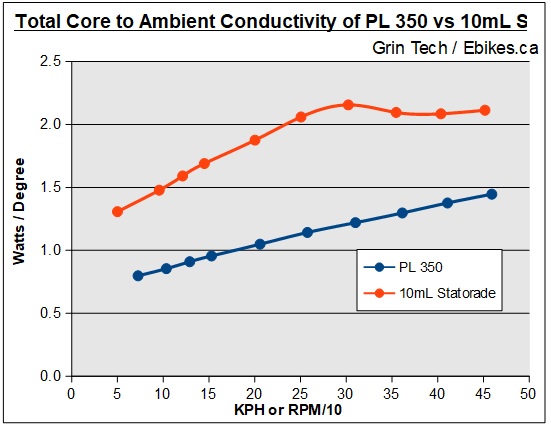
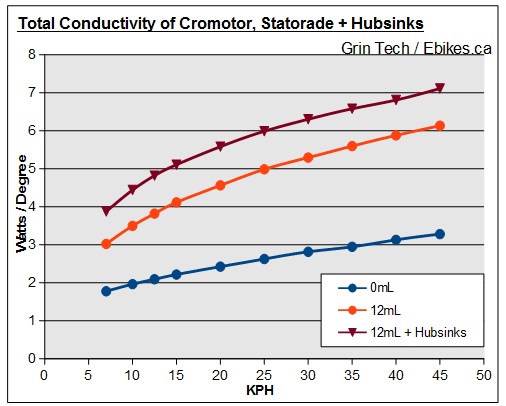
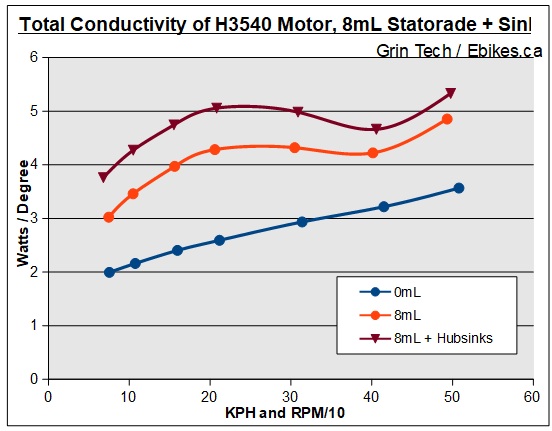
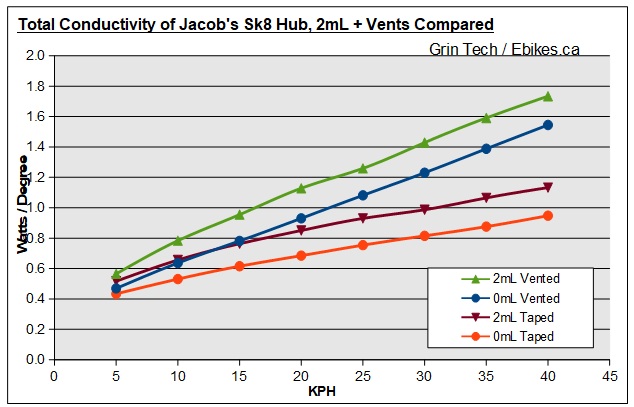
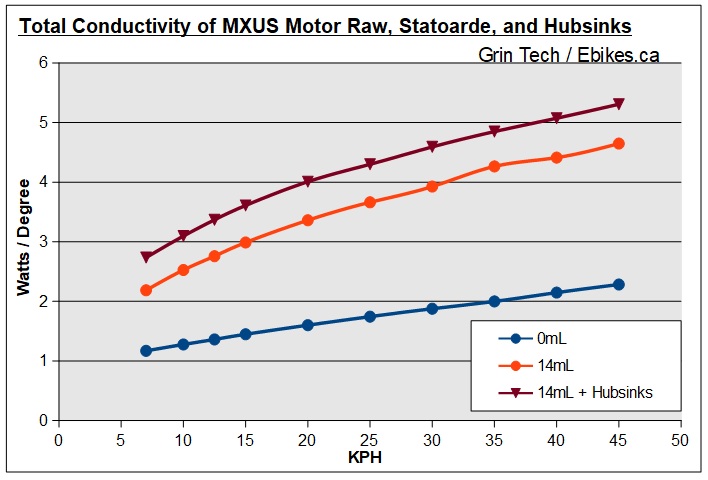
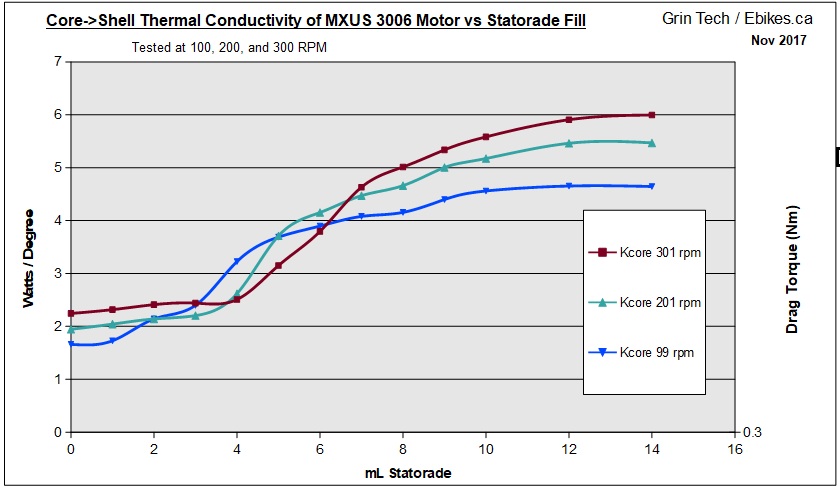
Frequently Asked Questions:
| G Force | 60 mm dia | 100 mm dia | 150mm dia | 200mm dia | 400mm dia |
| 5G | 390 rpm | 300 rpm | 240 rpm | 210 rpm | 150 rpm |
| 10G | 550 rpm | 420 rpm | 350 rpm | 300 rpm | 210 rpm |
| 20G | 770 rpm | 600 rpm | 490 rpm | 420 rpm | 300 rpm |
| 40G | 1090 rpm | 850 rpm | 690 rpm | 600 rpm | 420 rpm |
| 100G | 1730 rpm | 1340 rpm | 1090 rpm | 950 rpm | 670 rpm |

Be aware that inexpensive ferrofluids sold on ebay and the likes for demonstration / scientific purposes do not hold up at all in this motor application. Those are formulated for low cost and maximum visual effect, rather than long term stability at high temperatures and agitation levels.
Background
This discovery and research into ferrofluids for motor cooling resulted from our in depth thermal studies of hub motors, much of which is documented on the endless-sphere topic "Definitive Tests on the Heating and Cooling of Hub Motors" . We started this thread in early 2013 in order to characterize hub motor thermal behaviors, both to make a more accurate simulator model and to quantify the effects of air vent and oil cooling mods both of which were popular with hot-rodders at the time.
The thread is fairly lengthy but a good read. Some of the more interesting posts are:
Accounting for Motor Core Hysteresis Loss
Test Results in Still Air
Experiments with Internal Blades
Measuring Motor Core and Shell Heat Capacities
Concept for Internal Heat Transfer Fins
Building of Wind Tunnel
Infrared Camera Images
Observations of Drag Torque
Experiments with Potted Motor Core
Combinations of Vents + Statorade
Videos
Here is a video showing one method of adding Statorade to a hub motor without opening the motor first
Here is a video showing the effects of riding with and without Statorade on a small direct drive hub motor.
Deployment and Availability
Our goal was to have all direct drive motors supplied by Grin include Statorade by the end of 2016 and we have succeeded on this front. We started off with it in the TDCM internal geared hubs at the start of the year and shortly after introduced it in the 9C+ motor series. In late summer 2016 all of our new Crystalyte motors were Statorade compatible as well, with silicone sealant on the motor side plates and a through-hole inside one of the disk bolt holes for injecting the Statorade.And our more recent MXUS and Grin All-Axle hub motors are both sealed with Statorade injection ports.
We also offer stand alone 10mL syringes of Statorade to anyone who wants to experiment with adding it to their existing direct drive hub motor, as well as 50mL and 100mL bottles for those using it in larger quantities. The 10mL syringes are also available directly via Amazon for US customers. We have an OEM program for any motor manufacturers who want to purchase and consume it in volume.
Where to Order

 Canadian
Canadian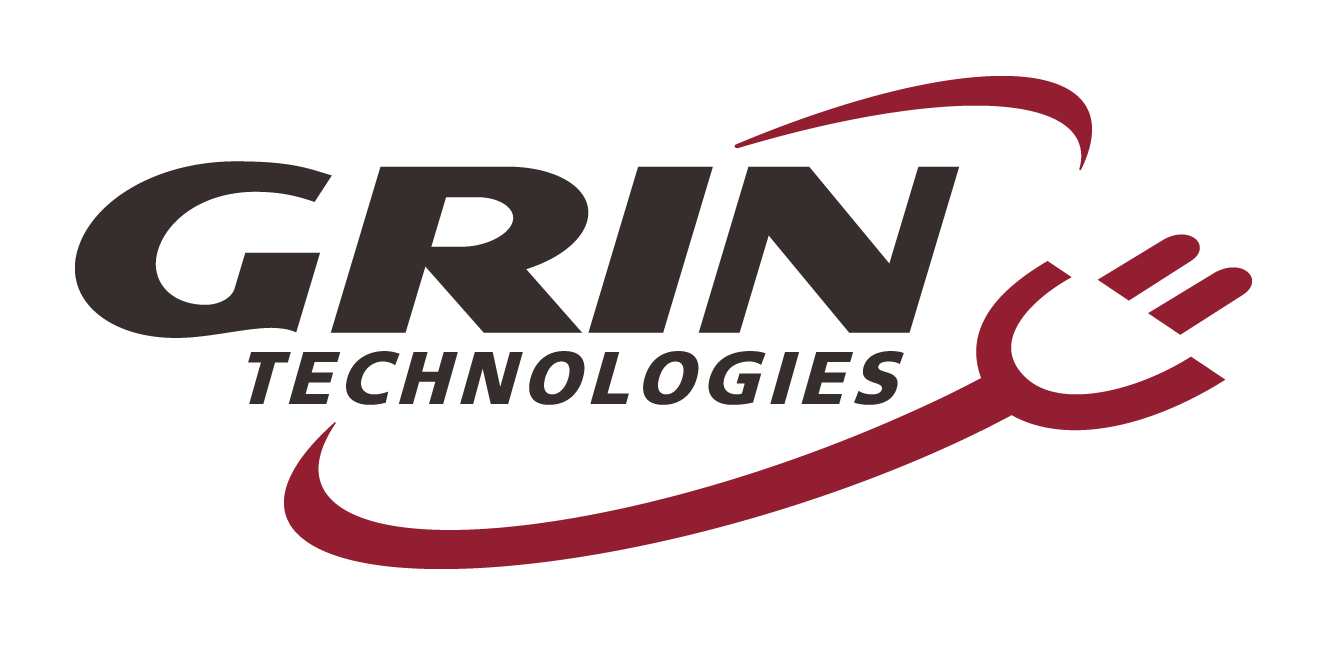
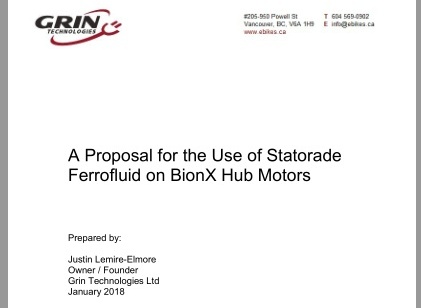
 Grin Tech Online Store
Grin Tech Online Store Get Statorade from Amazon.com
Get Statorade from Amazon.com